Raising Backyard Chickens – 11 Things Nobody Ever Told Me
There are books and articles galore filled with helpful tips on the subject of raising backyard chickens, but I’m here to tell you that they left a few things out!
Raising backyard chickens hasn’t always been a dream of mine. My interest in chickens was sparked a couple years ago, but I can’t tell you why I wanted to own chickens. It’s not because it’s a secret, I just don’t know. Many can tell you exactly where they were and what they were doing when they decided they had a dream to achieve. I cannot. What I can tell you, though, is that I live with a family of dream crushers. My daughter is not a fan of birds, my son is not a fan of chores, and my husband is not a fan of messes. They are, however, fans of baked goods and the occasional breakfast of bacon and fresh eggs.
I may not be able to tell you exactly when my interest was sparked, but I can tell you exactly when the family finally caved. The date was March 18, 2020. I left the house at 5:30 am on my hunt for pre-birds and the “Great White Northern”. Yes, a global pandemic had people hoarding all sorts of items, including toilet paper and chicken eggs. I had been preparing for the day the family would cave, so I had done my research and was ready to welcome my feathered friends! That’s when I quickly discovered that there were a few items missing from the books and articles I had read.
1. You need a support system
First thing to understand is that raising backyard chickens is not difficult or labor intensive, but it occasionally requires team work. If you are buying a coop that requires assembly, then you might need an extra set of hands to put the coop together. If you are leaving early, getting home late or traveling overnight, you will need help with getting the chickens cared for in your absence. What those books fail to mention is that you will need help. Maybe it should have been assumed, but some of us really need it spelled out. My initially reluctant family have stepped-up to become a great support system!

2. How many eggs do you really need?
Serious question. Have you ever considered how many eggs you will actually need? No-one ever asked me that!! If it was in the books I read, I totally missed it. There are several things to consider. Are you just eating the eggs or trying to make money selling them, too? How many people are you trying to feed? And how many eggs you need leads to how many chickens you will need, and that leads to how big of a chicken coop you will need. There’s math involved here folks, and this is not the fun “chicken math” we read so much about. This is sharpen-your-pencil-start-measuring-your-spaces-and-don’t-count-your-chickens-before-your-plan-is-hatched type of math.
Hens produce, on average, an egg a day. Their egg production is based on daylight hours, requiring 14 hours a day to signal the ovaries to release an egg. What this means is you will have an egg per chicken per day in the longer daylight months, and fewer eggs in the winter. You can do one of three things to ensure a steady supply of eggs: store excess eggs to use in winter months (freezing or using lime water, for example), manipulate the daylight hours with artificial light in their coop, or supplement with store bought eggs. Your answer to “How many eggs do I need?” now leads you back to how many chickens you need and how big of a coop you will need. The recommended space is 2 to 3 square feet per chicken in the coop, and 8 to 10 square feet per chicken in the outside run.
3. Raising backyard chickens requires backup plans
We decided to start small and grow from there. Our plan was to have two hens and keep the hen house small for now. We ordered a coop online and set-out to find a hatchery that sold our preferred breed.
Immediately we had to adjust a bit, because the minimum order was three day-old chicks. No biggie! Our small coop was said to accommodate 2 to 4 birds, we should be good. Four baby chicks arrived healthy and ready to enrich our lives. When the fourth chick hopped into sight from the back corner of the box, I immediately looked at the kids and said, “Your dad is going to kill me!” We were now raising four backyard chickens and realizing the coop would eventually be way too cramped.
To make a long story short, it took three tries to get the coop situation to everyone’s liking. It required some tears on my part, some caving on my husbands part, some creative thinking, and some heavy lifting. Our second try at keeping everyone happy was where we discovered the next item on my list.
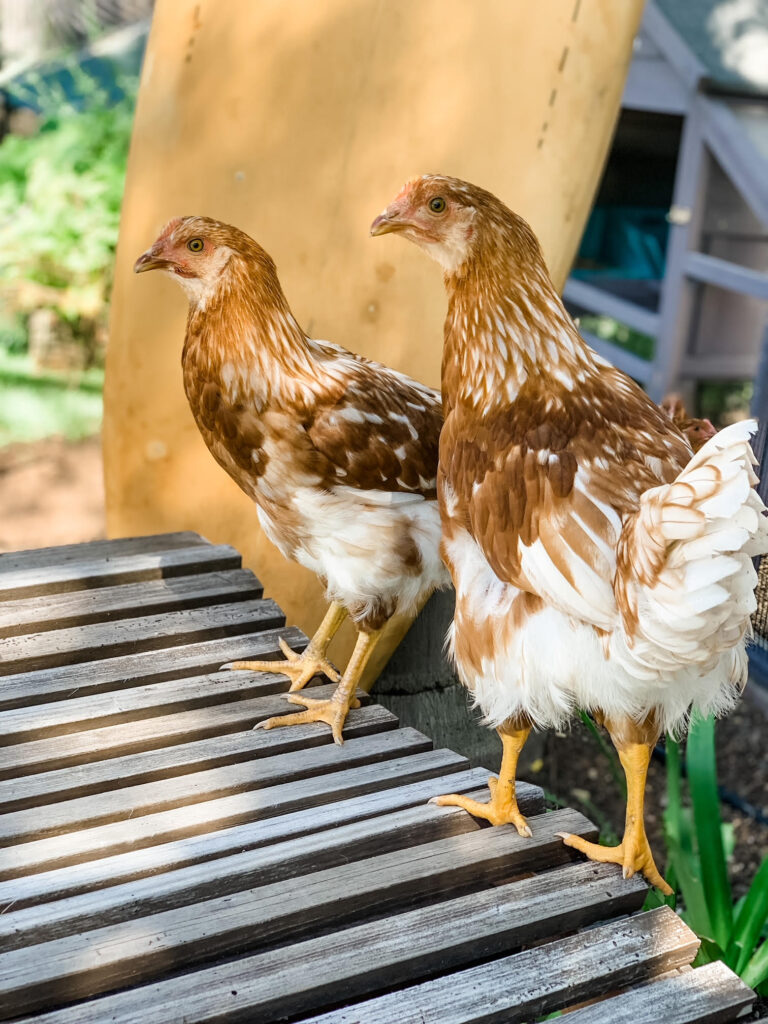
4. The MAGNITUDE of the manure!
Of course we knew that chickens pooped and I knew it was indiscriminately. What I didn’t know, and books have never been able to fully express, was the extraordinary amount they poop!! It’s a crap-ton!! An adult chicken poops approximately 15 times a day and it doesn’t stop at night. The night-time poop isn’t the problem, though.
Our second try at a solution for “too much chicken for the coop” situation was to let them free range around our yard during the day. They always went back to the coop at night and seemed comfortable with the roosting accommodations, even though it was a small space. At first, the chickens kept to our flower beds and loved spending the warm days taking long, satisfying dust baths amongst our huge banana plants. Perfect! After two months of this, though, they finally ventured onto our patio. And our patio furniture. And our picnic table. This is where we could easily see the amount of poop and it was both horrifying and fascinating, all at once!!
5. Cleaning chicken poop from unplanned areas
During the summer months, the poop dries out fairly quick. That’s a good thing and a bad thing. If it dries well, stains from the poop are not left behind on the concrete patio. Unfortunately, the poop doesn’t usually dry well, so it requires a pressure washer to remove the chicken poop stains from the patio. A scrub brush and mild detergent can be used, if you don’t have a pressure washer, but will obviously require more work. That brush and mild detergent will also work on patio furniture, just be sure to check labels before cleaning.
Interesting fact about our backyard is that it is on the north side of our house. Prevailing winds in the area where we live are from the northwest to southeast. What does that mean? That means small piles of dried chicken poop often collected at our patio door. Although unsightly and annoying, those piles are easily swept-up and added to our compost pile. A third try at a good living space was in order, before the second try became their final resting place.
6. The chickens are really good at finding their coop
We decided to convert the west side of our backyard into a chicken run. This was a neglected corner, because it’s not easily seen from the rest of the yard. The west side was the collecting spot for my unused pots, leftover flagstone, and the wheel barrow our son took apart to paint and never painted (or put back together).
We removed everything, put down bark, created a dust bath (which includes diatomaceous earth for mite control), put a few plants in pots, and moved their coop to the new area. To keep them in their new run, we bought a prefabricated gate, cemented poles in place, strapped the gate to the poles, and covered the area. I knew that chickens were good at making it back to their coop at night for safety, but what I didn’t know was just how good they are at finding their coop when it has been moved! I didn’t think they had been paying attention, but as dusk was approaching, they managed to find their coop.
7. Strange nesting behavior
I knew that the young chickens would act a bit strange in the days leading up to finding their nesting spot and laying their first egg. What I didn’t know was how I would have strange nesting behavior, too! Convinced the four would want better options for nests, I set out to find new nesting digs.
A $20 used nightstand from Goodwill seemed perfect. After sanitizing the nightstand, we stapled on some cute fabric as curtains, and made a nesting box from two of the three drawers. Wood shavings were placed in the two nesting drawers. The third drawer is used for storage. We were feeling pretty clever! The hens checked it out regularly, but all four hens eventually chose the very same nest box located in their coop. The curtains have been moved to the side, so the bottom drawer is now a feeding trough of sorts. The second nesting drawer, which was removed from the middle and placed on top of the dresser, is a way to peer inside our bedroom window.
Did I not mention that the third and final solution for their housing was right outside our bedroom? More on that in a bit…
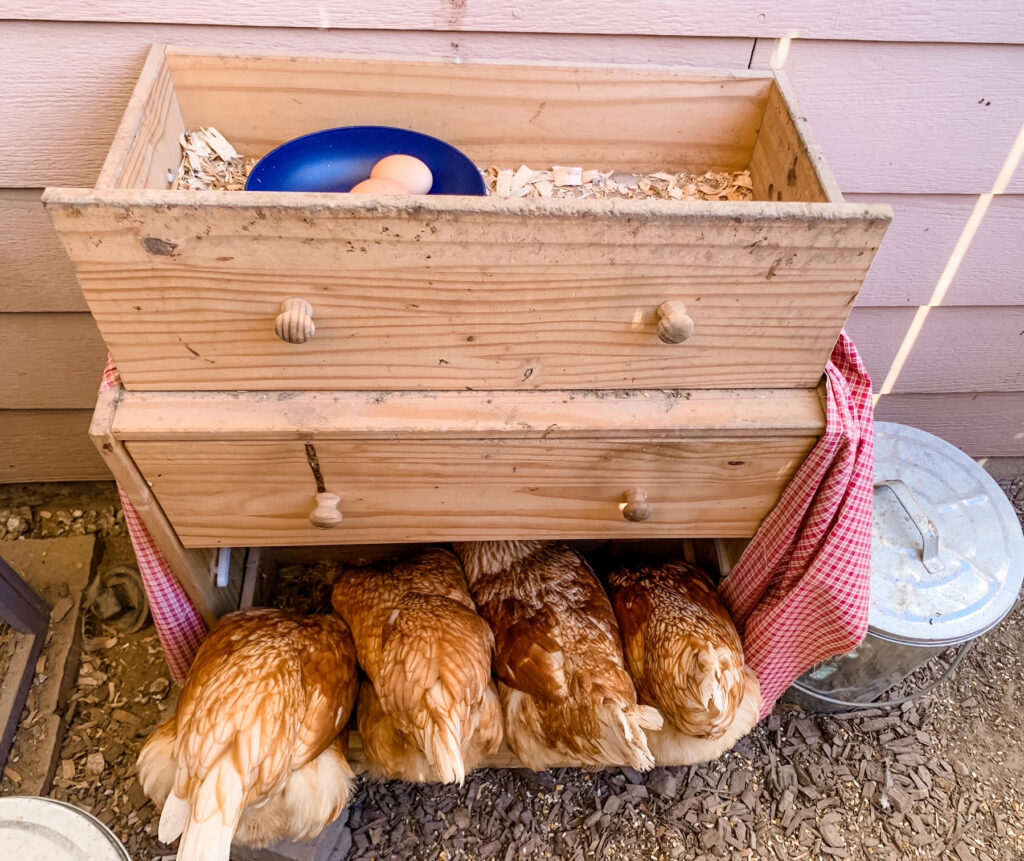
8. Raising backyard chickens can be dangerous
I suppose we all know that any critter gathering around your feet is a tripping hazard. What we didn’t know is that hens intentionally squat at your feet as you come close. I initially thought it was an attempt to topple me, either as a way to conquer and dominate me, or for quicker access to the treats I was carrying. Turns out that they are squatting as a form of submission. The squatting is a sign that they have reached sexual maturity. They typically squat for the rooster or as a sign of submission to the dominant hen. That’s both awkward and flattering. It can also be dangerous, so all kidding aside, it’s a good idea to make sure you have plenty of room to maneuver around the squatters.
9. Proud Parent
I had no clue the amount of excitement and pride I would feel with the first egg! A photo was snapped and sent to ALL friends and family that knew we were raising backyard chickens. It is such a feeling of accomplishment when they finally start laying their eggs! We hesitated cracking that first egg, but we were excited to see the rich yellow yolk everyone talks about. Didn’t know it was possible to think an egg yolk was so beautiful! I guess the hens have a good reason to “sing” about their egg every day.

10. The egg-laying song
After hens lay eggs, they are said to “sing a song”. All books and articles mention that they are not quiet after egg laying, but every-single-one I read called it a song. Do you know what “Screamo” is? Because that’s the type of song they sing! They squawk, bawk, clawk, and holler after laying their eggs. They can get pretty stinking loud! Our noisy brood are Cinnamon Queen chickens (cross of Rhode Island Red and Rhode Island White), but apparently different breeds sing at different volumes. Remember that I mentioned in item 7 that they are right outside our bedroom?
I’m sure a few of you are laughing right now at our misfortune. The truth is, it really hasn’t been bad having them right outside our bedroom. Rarely do they start “singing” when we are still trying to sleep and their “song” is usually a short song. I’m an early riser and half deaf, so they never bother me. My husband rises at 7:00 am and has rarely been disturbed by their song. Occasionally he has slept-in passed 7:00 am, though, and has been serenaded awake. In my opinion, the biggest difference in the noise of a rooster and the noise of a hen is actually timing. It’s all loud, but a hen isn’t usually singing at zero dark thirty!
Do remember this item when deciding on how many chickens you want, because that “song” is once a day per chicken. Also remember this item when considering how often your neighbors call in noise complaints.
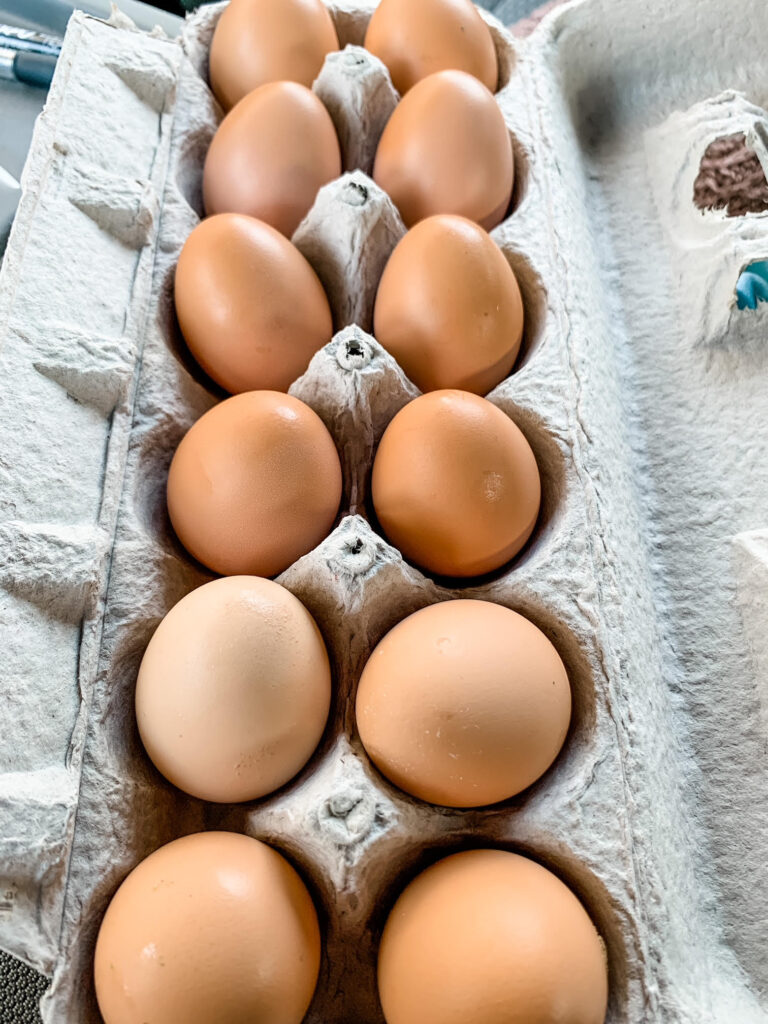
11. Not all backyard chickens like corn
We live in an area that gets cold weather in the winter and periodically freezes, so I was concerned about keeping the chickens warm. Every book and article I have read on the subject says that corn can help keep chickens warm and that chickens love cracked corn. Cracked corn is a great carbohydrate to feed during the winter months to help keep the chickens warm, because of the thermic effect that’s created during digestion. Each of my chickens have different tastes, but NONE of them will eat the corn! I have tried several different types of chickens scratch, each with varying sizes of cracked corn, but the corn always goes uneaten. Our chickens eat from my hand, but you can see from the photo below that my chickens just look at the corn. They do eat a couple of the other seeds included in the scratch, so they are still getting some of the “warming” benefit.
As a side note, we found out our dog would happily eat all the corn, if we let her. Unfortunately, we left the regular chicken feed and the scratch where our dog finally found it. Thankfully, we were close by when she found it, so she only got a small taste, but was ready to go back for more. Another lesson learned by us!

One thing all books and articles about raising backyard chickens agree on
The one thing everyone agrees on is that raising backyard chickens is definitely worth the time, effort, and learning curve! At the time I am writing this post, we are still in lockdown during the global pandemic and working from home. I don’t believe eggs are currently being hoarded at the grocery store, but I haven’t had to find out. And the bonus for me is that watching and caring for my small flock brings so much joy! They are an escape from the craziness of the day and a form of therapy. Raising backyard chickens may not be for everyone, but they have definitely enriched our lives. Even the reluctant family have enjoyed them!
What’s your experience?
Let me know in the “Comments” section below what you have learned the hard way about raising backyard chickens. I would love to hear about your findings!
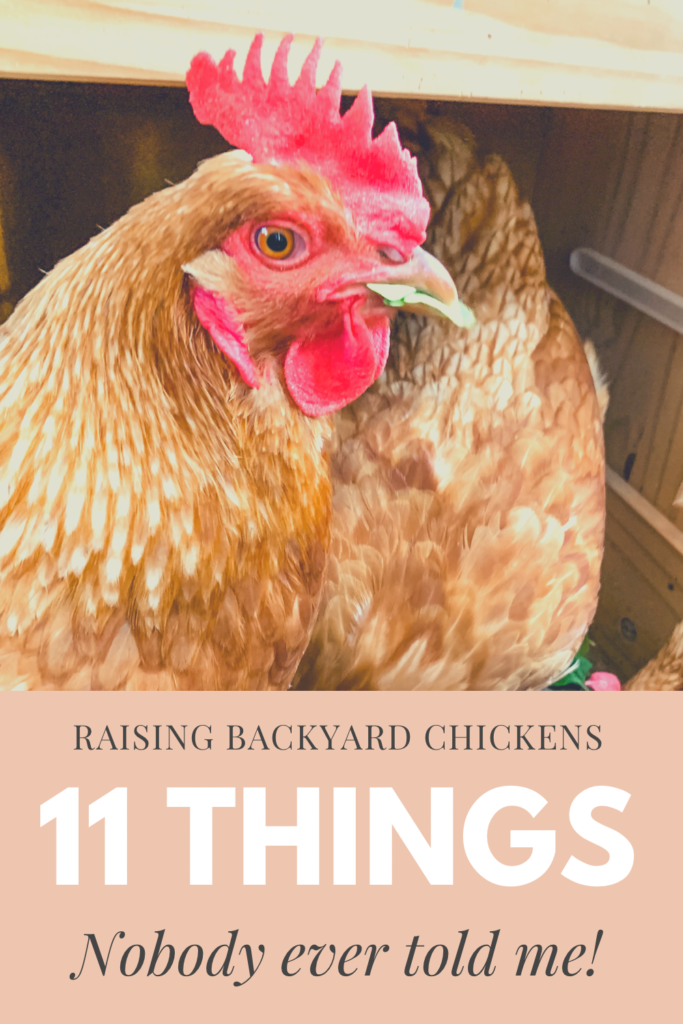

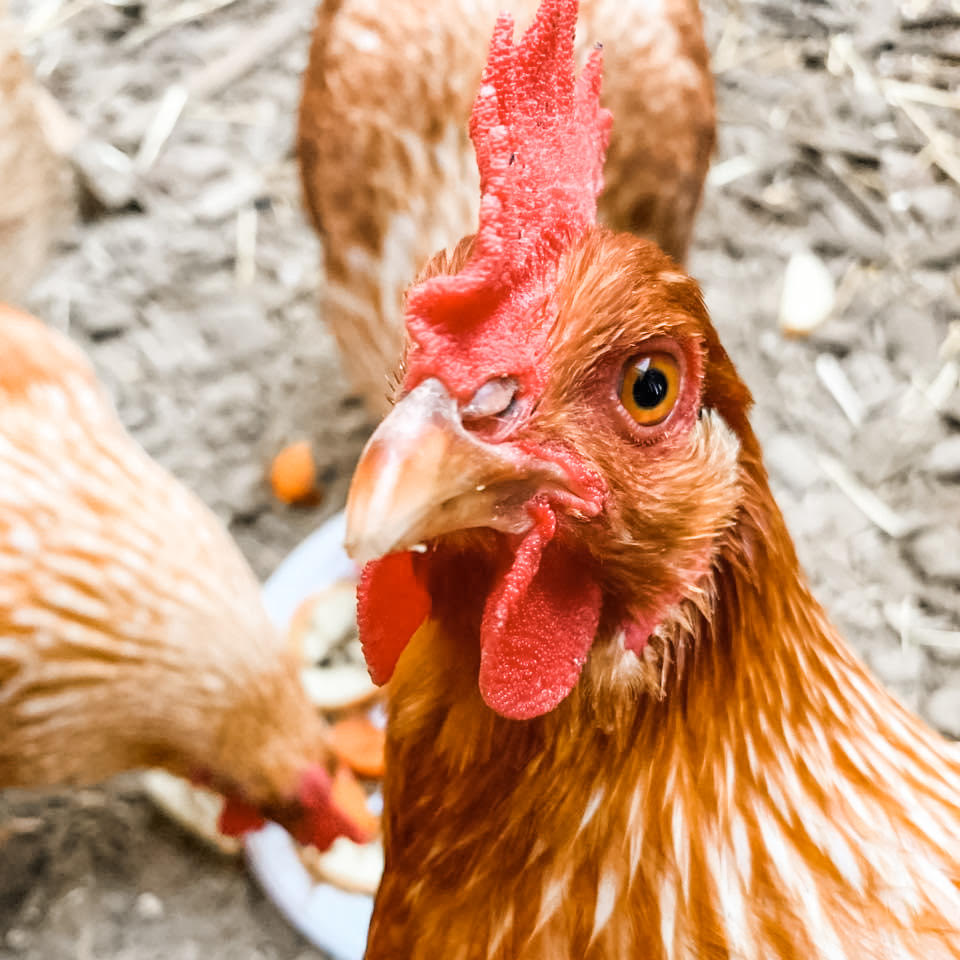

We’re flock newbies and we got our 1st egg yesterday! We were so excited that we did the same thing as you did. Texted pictures and announcements to all of our friends and family and posted it all over social media! Today, I realized when one of our olive eggers was about to lay, and I moved one of our security cameras inside the coop. My daughter and I got to watch it live! That was such a cool experience! Thanks for the great article and I hope you and your chickens are doing well!
Thank you for your comment, Mandi! The first egg is definitely an event to be celebrated! I have never been able to watch one of my hens lay an egg, so you have inspired me to move a camera into one of our henhouses!